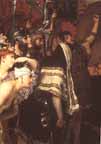

Two details from A Roman Emperor AD 41 (1872) by Lawrence Alma-Tadema. Baltimore, Walters Art Gallery. Click on thumbnails for larger images
Lawrence Alma-Tadema is perhaps best remembered for reflecting contemporary Victorian subjects in the classical Roman past, in essence, Victorianizing the Romans. In A Roman Emperor AD 41, however, Alma-Tadema breaks from his tendency of painting domestic scenes devoid of Roman emperors, gods, or battles. Instead, he recreates the murder of the emperor Caligula and the accession of his rather impotent uncle, Claudius. Alma-Tadema follows the account the Roman historian, Suetonius:
When the assassins of Gaius shut out the crowd under the pretence that the emperor wished to be alone, Claudius was ousted with the rest and withdrew to an apartment called the Hermaeum; and a little later, in great terror at the news of the murder, he stole away to a balcony hard by and hid among the curtains which hung before the door. As he cowered there, a common soldier, who was prowling about at random, saw his feet, and intending to ask him who he was, pulled him out and recognized him; and when Claudius fell at his feet in terror, he hailed him as emperor. [quoted by Barrow, 61]
Alma-Tadema's allusions to Seutonius' description are unmistakable. The scene is set in the Hermaeum (House of Hermes), as shown by the blood-stained herm, or bust, of Augustus in the background. Claudius, a renowned coward, imperial imbecile, and unlikely candidate for emperor, shrinks away in horror as the guard recognizes his bright red shoes and true identity. Caligula too can be recognized by his feet; he is almost surely the owner of the bright green boots protruding from the pile or corpses. As the art historian R.J. Barrow has noted, the green boots are "a witty reference to Caligula's name, meaning 'little boots,' coined when as a child he wore the costume of a soldier, military boots and all" (62)
The entire painting, in fact, is a witty critique of Rome, juxtaposing the ignoble present with a more heroic past. Thus in spite depicting famous subjects, A Roman Emperor shares a common theme with the artist's more homely paintings: it is unheroic. The painting differs from daily life images, however, in that it is no model of greatness Britons could easily relate to, or would even want to identify with. The subjects are simultaneously regal and pitiful. There is an obvious discrepancy between Claudius' imperial standing and withering physical position. A wall painting of the battle of Actium, celebrating Octavian's victory over Mark Antony and Cleopatra in 31 BC, is ominously cut off. On the right side of the canvas stands the imperial family's domestic alter, "highlighting the fact that Caligula was murdered before the very alter of his more noble ancestors." Like his literary inspiration Suetonius, Alma-Tadema imbues this event with amused irreverence and irony.
Questions
How does the painting's highly realistic style lend itself to Suetonius' description of Caligula's death?
How do the subjects' appearances in this painting differ from Alma-Tadema's other works?
Why might he want them to appear more Roman in this case? Why would this painting be pertinent to Britons in 1872?
Bibliography
Barrow, R. J. Lawrence Alma-Tadema. London: Phaidon, 2001.
Last modified 6 February 2007